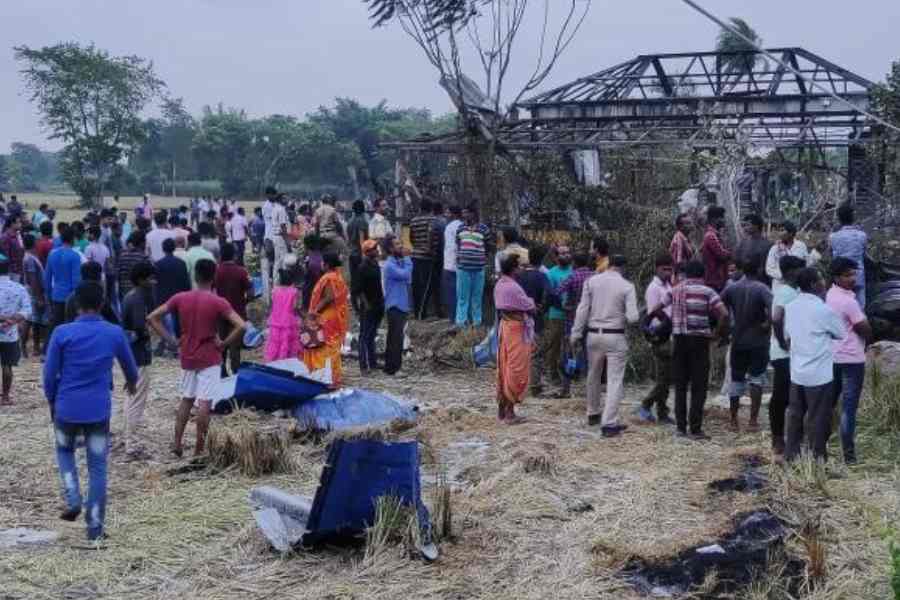Ambika Maiti and Madhabi Bag would not have exposed themselves to the hazardous job at an illegal firework factory had they not been driven to desperation by the lack of work under the 100-day rural job scheme whose funds in Bengal have been frozen by the Centre, suggest accounts from the explosion site that killed at least nine people on Tuesday.
Ambika and Madhabi are among the nine who were killed in the blast in East Midnapore’s Egra.
Ambika, 50, had joined the factory in April, seeking to share the burden of educating their three daughters, her husband Suresh said.
Although the illegal factory had been functional for the past 10 years barely 500 meters from their home in Khadikul village, Ambika had never earlier thought of engaging in the high-risk job, Suresh said.
“She was forced to join the factory and it claimed her life. The job in that factory was the last option for us to sustain the family after work under the 100-day scheme stopped in the area. We both have job cards and used to work under the scheme. I could not prevent her from going to the factory, considering the education of our three daughters,” said Suresh, a marginal farmer.
Madhabi’s story is similar. A resident of the same village, she had started working at the factory in November last year after work under the Mahatma Gandhi National Rural Employment Guarantee Act (MGNREGA), the lifeline of the rural economy, dried up.
Sanjit, her husband and a farm labourer, said he sent his wife to the factory after both of them lost the steady income generated by the rural jobs scheme.
Work under the MGNREGA in Bengal virtually came to a standstill last year after the Centre stopped the release of funds under the scheme, acting on complaints of anomaly lodged by the state BJP. Last month, moving the Supreme Court, an NGO, Swaraj Abhiyan, had said: “While the Centre defends freezing West Bengal’s funds citing implementation irregularities, it has not registered a single FIR or imposed a single penalty on a single government functionary in the state.”
The Union rural development ministry withheld Rs 3,000 crore meant for wages and Rs 3,500 crore meant to cover for material costs in the last financial year and hasn’t released any money in the ongoing fiscal either.
Chief minister Mamata Banerjee has on numerous occasions pleaded with Prime Minister Narendra Modi to release funds under the scheme to clear the dues of those who had worked on the projects. However, the requests from her and her government have fallen on deaf ears. Bengal has around 1.4 crore job cardholders.
Ambika and Madhabi were among 60-odd women who used to prepare containers and package firecrackers at the illegal factory.
“I permitted her to work there as the women were not usually made to handle explosives. Our family’s dire needs blinded us to the risks,” Suresh said.
Suresh had been a migrant labourer in Delhi, but could not return to his workplace after the pandemic.
According to him, the couple used to earn Rs 20,000 annually from MGNREGA wages, in addition to their regular income from agriculture after returning from Delhi. Suresh also worked as a daily labourer to augment his income.
A woman working in such illegal factories earns Rs 250 daily — with around 15 days of work in a month. The wages of an unskilled labourer is Rs 237 under the MGNREGA. According to a district official, the people in the area used to get work for around 45-50 days a year under the central government scheme.
“Yes, the income of my wife from the firework factory was slightly more than what we earned through the 100-day employment guarantee scheme. But I would not have sent her there if we had got work under the NREGA,” Suresh said, adding he was badly in need of money to educate his daughters.
Suresh and Ambika’s eldest daughter joined a private hospital in North Dinajpur in March this year after securing a diploma in nursing. Another daughter is pursuing the same course at a private college, while the youngest daughter appeared for the Madhyamik this year.
Local administration officials and gram panchayat functionaries said the illegal factory’s owner, Krishnapada Bag, used to hire workers from outside the area.
“He used to hire people from Murshidabad and Malda. After the 100-day scheme work stopped, local villagers, especially women, started approaching him for work, which suited him as he got local labour at cheaper rates,” said Milan Kumar De, deputy chief of the Sahara gram panchayat.
Surajit Mukhopadhyay, dean of social science at the Royal Global University in Assam’s Guwahati, said: “The scheme used to provide a steady and guaranteed income to lakhs of families in the state. The absence of the scheme has broken the backbone of the rural economy, and that is why even women are forced to join risky jobs. I believe the picture is quite similar in other places too. I hope the Centre and the state solve their conflicts and the scheme is resumed.”











